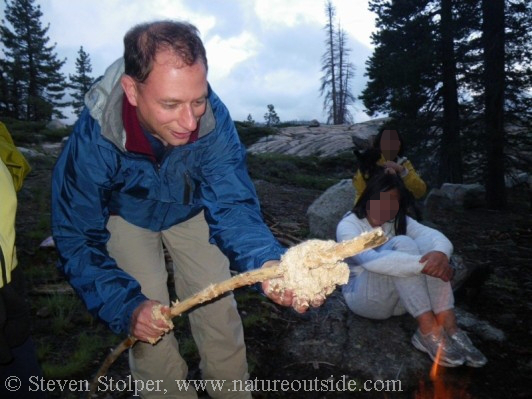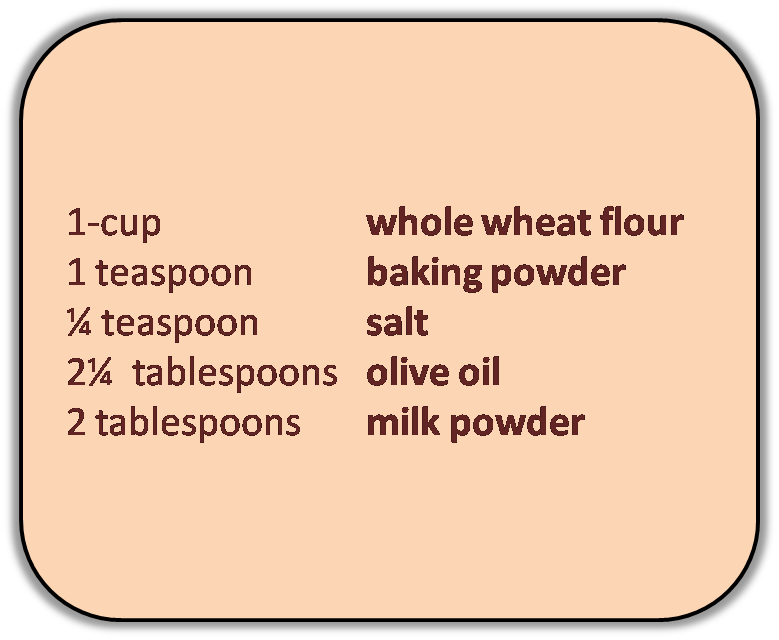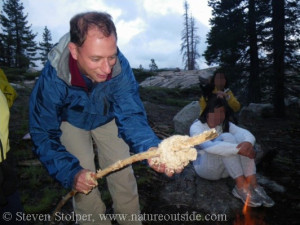
This is what a bannock disaster looks like!
I hope this gives you a chuckle. I stumbled across this picture taken several years ago. I am trying to make bannock, on a stick, over a campfire, in the rain.
Bannock is a type of flat bread. I have heard it is of Scottish origin. But I do not know for certain. The bread has been in use for hundreds of years as a trail food because it has a simple list of ingredients that are easily carried and prepared.
My Bannock Recipe
Many variations of bannock exist and people have their own favorite recipes. Here is my recipe, which I have been making for the last six years. I often add raspberries if the mood takes me. You can also add nuts, herbs, or other ingredients that go well inside bread. Use your imagination!

Simple Bannock Recipe
The baking powder is a leavening agent that softens the bread. The olive oil is equivalent to 3 tablespoons of butter. But it is easier to transport than butter because it does not require refrigeration.
Transport and Preparation
I mix the powdered ingredients before I leave home. I carry them in a plastic zip-lock bag. I store the olive oil in a small plastic or glass container. The ingredients don’t take up much space in my pack and the allure of baking bread over the campfire is irresistible.
When I am ready to prepare the bread, I slowly introduce water to the powdered ingredients and mix the dough right in the plastic bag. Adding water is the tricky part! If you add too much, it becomes a gooey mess. Too little and the powdered ingredients don’t become dough. Also, you do not have to knead bannock dough like for other breads.
Cooking
There are three ways I would recommend you prepare bannock.
Pan
The first is to place it into a cast iron pan or a pan made from blue steel. Cast iron is very heavy, so I have a blue steel pan to use when backpacking. However, I have yet to try my blue steel pan.
Lightly oil the pan and place the dough into it. Prop the pan at an angle facing the campfire using a small stick as a support. Judging when the bread is fully cooked can be difficult because of the variables involved with cooking outside. You will be able to get an idea from looking at it. You can also poke a small twig into the bread to get an idea of its internal consistency.
Dutch Oven
The second method uses a dutch oven. Needless to say, this technique is better suited for car camping. Lightly oil the oven and place the dough into it. Cover and cook on the ashes of the fire. Place ashes on the top of the oven as well. Once cooked, you can brown the top of the bread by putting it in a pan and propping it next to the campfire as described above.
On a Stick
Each time I have backpacked, I cooked the bannock using a third technique: on a stick.
Find a suitable stick. I use dead branches because I practice “leave no trace” camping techniques whenever I can. Remove the bark using your knife. The bark can harbor bacteria and removing it makes the stick more sanitary. Coil the dough around the stick. Then cook the dough over the fire.
My Calamity
This brings us to the picture I found…
 I am lousy at many things. But chief among them is any type of food preparation. I could burn water if given the chance. My cooking rivals the three stooges for calamity.
I am lousy at many things. But chief among them is any type of food preparation. I could burn water if given the chance. My cooking rivals the three stooges for calamity.
I was backpacking with urban youth in the Emigrant Wilderness in the Sierra Nevada. It was raining intermittently, but the rain had abated and we were in good spirits. We had a good campfire. So it was time to make some after-dinner bannock!
What a disaster! I always seem to grow impatient as I add the water to the powdered ingredients. This night was no different. I added way too much water. The rain further diluted the dough as I wrestled it onto the stick.
Hoping for the best, I started to cook. The dough stayed on the stick just long enough to start smelling good. Then the coils separated and it slipped into the fire. 😥
The kids were quite amused by the whole process – from my struggle coiling the dough to its final plunge into the fire. Everyone enjoyed a hearty laugh at my expense. As Mark Twain famously quipped:
Good decisions come from experience, and experience comes from bad decisions.
I got some good experience that evening. 😀
Try it yourself
Despite my misadventures, you should try this recipe for yourself. You can rehearse in your kitchen by setting your oven to 350-400 degrees and checking it periodically.
One more thing, bushcraft expert Ray Mears says it is bad luck to cut bannock. So break it with your hands instead. It may help keep your next one out of the fire. 🙂
Share your own food misadventures and make me feel a bit better. Tell your story in the comments section, below.
Related Articles on NatureOutside
Bushcraft Dessert – Make a Lavender Dip for Strawberries
If you enjoyed this article you might like others in the edibles section.



Hi,
Nice one. I first tested this at home and its a lot like baking bread (which I like to do occasionally totally by hand). By now you’ll have it spot one.
With bannock, I usually use a frying pan. Pretty much similar recipe, though I like to add 1 tbsp honey and a good handful of raisins per cup of flour.
Some info which might help someone, humidity greatly affects the amount of water required in doughs. The difference between a dry and a wet dough is surprisingly small. Can be as little as 3 or 4 tablespoons.
Suggestion:
Reserve 2 tbsp of dry mixture (just in case)!
Add 90% of the water. General guidance would be 1 cup flour to 1/2 cup water (or 225ml flour – 125ml water).
Once the dough is nearly there, add the reserved mixture to coat the dough.
Im off to home-cook one now. 🙂
Cheers and thanks for the post.
Pedro, thank you for the terrific tips! Reserving some of the dry mixture is a terrific idea. Besides coating the dough, I use it to recover if I get too enthusiastic with the water. I like to add raspberries to mine. 🙂
That’s exactly the intention. ☺
Also, using 2 sticks a couple of inches apart might also help prevent the dough rotating and falling flat.:)
I never thought of this. I’ll give it a try!
Bannock It’s self as a word is Scottish, but the food is deeply rooted in indigenous culture. It was originally made with wild turnip but when colonization of Canada began, people started making bannock out of wheat flour.
The easy ingredients that are convenient for trail food originated from the fact that it was made out of government rationed food.
Thank you for your comment, April. Indeed, I have made bannock with indigenous people from Canada’s pacific northwest. Until that moment, I had not realized there was a connection between bannock and native culture.